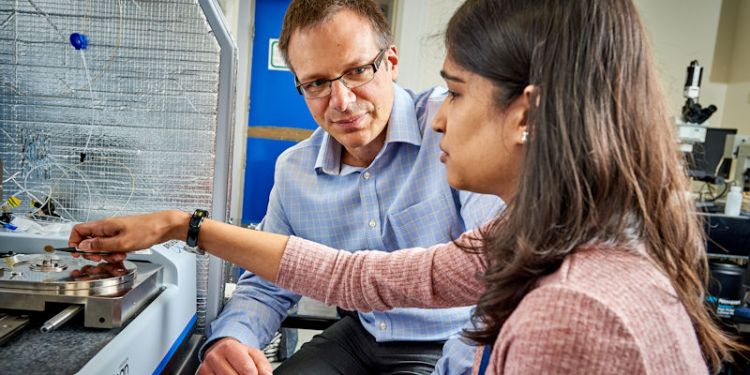Bio-nanoelectronics

Professor Walti is working with a team of postgraduate researchers who use atomic force microscopy as part of their research into cell separation
A promising route for the directed assembly of nanoscale components is molecular self-assembly, which endeavours to take advantage of the specific lock-and-key recognition properties inherent in many (bio)molecular systems.
We are following a number of pathways to introduce biological functionality into nanostructured electronic devices. These new methodologies could be used in new molecular sensors, for memory and switching operations and as a means of directed 3D assembly.
Our bio-nanoelectronics suite offers molecular biology facilities – PCR cyclers, centrifuges, agarose and polyacrylamide gel electrophoresis and microreflux apparatus – tailored to support our DNA and protein work. These are complemented by a large range of electrical characterisation equipment and tools for nanoscale manipulation for techniques such as:
- Electrochemical surface plasmon resonance
- Dual polarisation interferometry
- Fluorescent microscopy
- Confocal laser scanning microscopy
- Total internal reflection fluorescence microscopy
- Atomic force microscopy
- Scanning tunnelling microscopy
- Scanning electron microscopy
- AC and DC electrochemistry
Our expertise
- Controllable conformational change – using electric fields to control the movement and conformation of DNA and other molecules for nanostructure assembly and function
- Patterning of DNA scaffolds – exploring how macromolecules such nucleoprotein filaments based on the DNA binding protein RecA can create functional biologically templated materials for molecular-scale patterning, metallisation and lithography applications
- Functional materials – creating novel functional materials by introducing peptide aptamers into the coat proteins of rod-like viruses (TMV, phage), triggering controlled surface modification, e.g. allowing them to bind gold nanoparticles and create conducting wires
- Miniaturised protein arrays – capable of label-free electronic sensing with high sensitivity and high specificity; use of this scalable detection technique in highly multiplexed devices with increasingly smaller detection areas and higher sensitivities, with the possibility of simultaneous monitoring of tens or hundreds of thousands of protein isoforms.
Further information
View all members of our research group and publications.
PhD projects
We have opportunities for prospective postgraduate researchers. Find out more.
Contact us
If you would like to discuss an area of research in more detail, please contact a relevant member of the research team.

